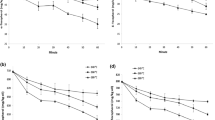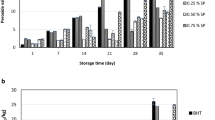Abstract
Flaxseeds were roasted at 1150 W/m2 radiation intensity with short and medium wave infrared (IR) emitters for specific durations, which provided good visual and sensory quality. The effects of IR roasting on color properties, hydrogen cyanide (HCN) content, tocopherols and fatty acid composition of the flaxseed and flaxseed oil were investigated. Further, flaxseeds were stored for 6 months and free fatty acid content and peroxide values were followed at 1-month intervals to understand the effect of IR treatment on hydrolytic and oxidative stability. HCN content of the flaxseeds was reduced up to 59% with IR roasting. Tocopherol content of the IR roasted flaxseed oil was higher than that of the control. No notable variation was observed in fatty acid composition with regard to IR treatment. Free fatty acid content of IR roasted flaxseeds did not increase during storage, while peroxide value of the seeds significantly increased up to 95 mEq O2/kg oil.

Similar content being viewed by others
References
Freeman SC (1995) In: Cunnane LU (ed) Flaxseed in human nutrition. AOCS, Champaign
Goyal A, Sharma V, Upadhyay N, Gill S, Sihag M (2014) Flax and flaxseed oil: an ancient medicine and modern functional food. J Food Sci Tech 51:1633–1653
Muir AD, Westcott ND (2003) In: Muir AD, Wescott ND (eds) Flaxseed constituents and human health. Taylor & Francis, London
Morris DH (2001) Essential nutrients and other functional compounds in flaxseed. Nutr Today 36:159–162
Bhatty RS (1995) In: Cunnane SC, Thompson LH (eds) Flaxseed in human nutrition. AOCS, Champaign
Cardoso Carraro JC, de Souza Dantas MI, Rocha Espeschit AC, Duarte Martino HS, Rocha Ribeiro SM (2012) Flaxseed and human health: reviewing benefits and adverse effects. Food Rev Int 28:203–230
Singh KK, Mridula D, Rehal J, Barnwal P (2011) Flaxseed: a potential source of food, feed and fiber. Crit Rev Food Sci 51:210–222
Muir AD (2010) Flax lignans: new opportunities for functional foods. Food Sci Technol Bull Funct Foods 6:61–79
Hall C, Tulbek MC, Xu Y (2006) In: Taylor SL (ed) Flaxseed. Elsevier, San Diego
Oomah BD (2001) Flaxseed as a functional food source. J Sci Food Agr 81:889–894
Feng D, Shen Y, Chavez ER (2003) Effectiveness of different processing methods in reducing hydrogen cyanide content of flaxseed. J Sci Food Agr 83:836–841
Wu M, Li D, Wang LW, Zhou YG, Brooks MSL, Chen XD, Mao ZH (2008) Extrusion detoxification technique on flaxseed by uniform design optimization. Sep Purif Techol 61:51–59
Krishnamurthy K, Khurana HK, Jun S, Irudayaj J, Demirci A (2008) Infrared heating in food processing: an overview. Compr Rev Food Sci F 7:2–13
Sakai N, Hanzawa T (1994) Applications and advances in far-infrared heating in Japan. Trends Food Sci Tech 5:357–362
Yılmaz N, Tuncel NB, Kocabıyık H (2014) Infrared stabilization of rice bran and its effects on gamma-oryzanol content, tocopherols and fatty acid composition. J Sci Food Agr 94:1568–1576
AACC (2000) Approved methods of american association of cereal chemists, 10th edn. Eagan, Minnesota
AOAC (2000) Official methods of analysis of the association of official analytical chemists, 17th edn. Maryland, USA
ISO (1995) Animal and vegetable fats and oils—analysis by gas chromatography of methyl esters of fatty acids. European Standard EN ISO 5508
AOCS (1997) Official methods and recommended practices of the american oil chemists’ society. AOCS, Champaign
Sargi SC, Silva BC, Santos HMC, Montanher PF, Boeing JS, Santos Junior OO, Souza NE, Visentainer JV (2013) Antioxidant capacity and chemical composition in seeds rich in omega-3: chia, flax, and perilla. Food Sci Tech 33:541–548
Bozan B, Temelli F (2008) Chemical composition and oxidative stability of flax, safflower and poppy seed and seed oils. BioresourTechnol 99:6354–6359
Kajla P, Sharma A, Sood DJ (2015) Flaxseed—a potential functional food source. J Food Sci Tech 52:1857–1871
Cressey P, Saunders D, Goodman J (2013) Cyanogenic glycosides in plant-based foods available in New Zealand. Food Addit Contam Part A 30:1946–1953
Vaidya B, Choe E (2011) Effects of seed roasting on tocopherols, carotenoids, and oxidation in mustard seed oil during heating. J Am Oil Chem Soc 88:83–90
Lee YC, Oh SW, Chang J, Kim IH (2004) Chemical composition and oxidative stability of safflower oil prepared from safflower seed roasted with different temperatures. Food Chem 84:1–6
Yoshida H, Takagi S (1997) Effects of seed roasting temperature and time on the quality characteristics of sesame (Sesamum indicum) oil. J Sci Food Agr 75:19–26
Malcolmson LJ, Przybylski R, Daun JK (2000) Storage stability of milled flaxseed. J Am Oil Chem Soc 77:235–238
Przybylski R, Daun JK (2001) Additional data on the storage stability of milled flaxseed. J Am Oil Chem Soc 78:105–106
Turner CT (2013) Effects of pasteurization (heating) on milled flaxseed quality. Master of Science Thesis, Department of Cereal and Food Sciences, Fargo
Schorno AL, Manthey FA, Hall CA III (2010) Effect of particle size and sample size on lipid stability of milled flaxseed. J Food Process Pres 34:167–179
Acknowledgements
The authors would like to thank to the Turkish Scientific and Technological Research Council (TUBITAK) for supporting this research (Project No: 212O937) and for the scholarship granted to Ayşen UYGUR.
Author information
Authors and Affiliations
Corresponding author
Ethics declarations
Conflict of interest
The authors declare no conflict of interest.
About this article
Cite this article
Tuncel, N.B., Uygur, A. & Karagül Yüceer, Y. The Effects of Infrared Roasting on HCN Content, Chemical Composition and Storage Stability of Flaxseed and Flaxseed Oil. J Am Oil Chem Soc 94, 877–884 (2017). https://doi.org/10.1007/s11746-017-2982-2
Received:
Revised:
Accepted:
Published:
Issue Date:
DOI: https://doi.org/10.1007/s11746-017-2982-2




